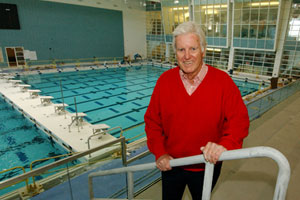 |
|
||
|
|||
A plunge into retirement
Wetmore, the founding father of BU swimming program, to quit after three decades of success
By Brian Fitzgerald
|
|
Reagh Wetmore, who has coached the BU men’s and women’s swim teams for 30 years, in the seating area of the new pool at the Fitness and Recreation Center. Photo by Vernon Doucette |
|
How long has Reagh Wetmore loved swimming? He first immersed himself in it 78 years ago, when his family moved from Nova Scotia to Florida. As a three-year-old, much to the chagrin of his parents, he liked to walk down to the end of a pier and jump in the ocean, truly earning his last name.
“Someone would always pluck me from the water before I drowned,” he says with a laugh. Then again, he probably would have figured out how to swim to shore anyway: a year later, after watching people ride waves, Wetmore (SED’92) taught himself how to bodysurf.
At 81, Wetmore still swims often, but the 30-year coach of the men’s and women’s swimming teams recently announced his retirement. He will remain at BU through December, however, to work with Terrier swimming alumni before his full retirement.
He leaves a swimming program that under his direction has won 13 team titles and 172 individual conference titles and produced two All-Americans and three Olympians. Wetmore, who was named America East Coach of the Year four times, has been at BU long enough to remember when his athletes didn’t have a pool. And he will be on hand when the University christens its second competition pool with next month’s opening of the new Fitness and Recreation Center.
Known as “Doc” because of his doctorate in education, Wetmore has mixed feelings about his retirement. On one hand he knows that the new pool, with 10 lanes — compared to 6 lanes in the Case Athletic Center’s Faneuil Pool — will mark an exciting new era in Terrier swimming. The new pool area will have the capacity to seat 700 spectators, instead of the 200 of the old pool. The new pool will also have a movable bulkhead separating the swimming and diving areas, so both swimmers and divers can practice and compete simultaneously.
“Of course I’m looking forward to the new pool,” he says. “What coach wouldn’t? It’s already making it easier to recruit athletes.” Then again, Wetmore notes, he will celebrate his 82nd birthday in July, and legendary baseball manager Casey Stengel was seven years younger when he hung up his spikes. “And when Babe Ruth was nearing the end of his career,” Wetmore says, “newspaper reporters used to point out that he was getting old, and they’d ask him how long he was going to keep playing. He used to say, ‘I’m not going to play until I drop, but I’m going to play until I almost drop.’ That was a conversation-stopper.”
Kidding aside, Wetmore says he intends to stay involved with the BU swimming community for a long time. “But it’s time to retire,” he says.
From Atlantic to Pacific
|
|
Wetmore teaching his downproofing technique to a BU swimming class at the Faneuil Pool in the Case Athletic Center in 1978. Photo by BU Photo Services |
|
Wetmore started swimming competitively at six, when his family moved back to Nova Scotia. As a teenager, he and his friends built a makeshift “pool” on a lake in the city of Yarmouth, using rafts as boundaries. Needless to say, the air and water in the Great White North was a bit colder than in the Sunshine State, but Wetmore couldn’t get enough of the sport.
“We’d go out there swimming in October, with nothing but hot cocoa and towels to warm us up,” he says, “but we loved it.”
A record-breaking swimmer at Acadia University, he began his coaching career in Honolulu, where his Mid-Pacific team won an interscholastic Hawaiian championship. He later coached at Phillips Academy in Andover, Mass., for 12 years and guided the team to become a national prep school powerhouse.
While at Phillips, Wetmore developed a drownproofing technique that allows people to survive in the water for great lengths of time. His method, a modified version of the breaststroke that involves periodically propelling oneself upward for air, is designed to prevent waves from washing over the face and into the nose and mouth. He has presented the technique on such television shows as Good Morning America and Today.
Wetmore is known as much for his recruiting prowess as for his coaching ability. For example, he gave Kidija Breznikar (CAS’07), from Kotpje, Slovenia, a full scholarship, and she set the University record for the 200-yard breaststroke and the 400-yard individual medley, even though she usually swims in the 200-yard medley.
“It has always been my dream to come to the United States and study and swim here, and Doc gave me that opportunity,” says Breznikar, who says that she swam in high school, but didn’t participate in the sport for a year because Slovenia doesn’t have competitive collegiate swimming. Wetmore, however, was impressed with her swimming times, and knew his team could use her. “Doc is one of the people that made me love swimming again,” she says.
Wetmore was “like a father to us,” according to former Terrier swimmer Sheryl Cotter Bierden (SAR’95,’97). Indeed, he is literally the founding father of Boston University’s swimming program. And like a proud parent, he likes to brag about his “kids.”
“We’ve had some incredible athletes here over the years,” Wetmore reflects. “It’s a great swimming program, and it’s going to get even better with our new facilities.”
![]()
18
March 2005
Boston University
Office of University Relations

